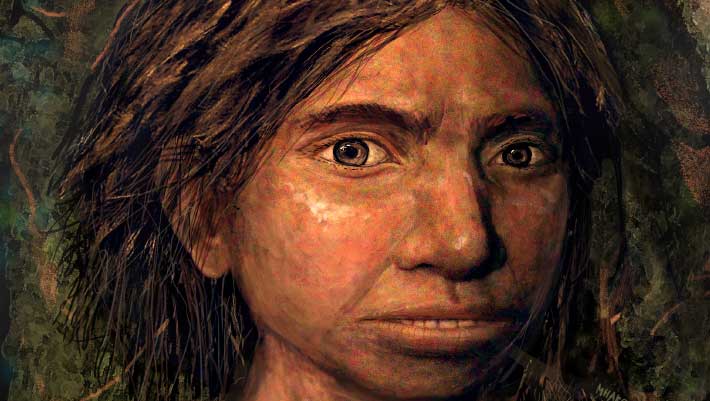Denisovans Survived on Tibetan Plateau until 48,000-32,000 Years Ago

Top Stories Tamfitronics
Archaeologists have found a new hominin rib specimen in Baishiya Karst Cave, one of the only two places where Denisovans are known to have lived. Dated to 48,000-32,000 years old, the specimen also belongs to the Denisovan lineage, extending their presence at the cave well into the Late Pleistocene.

A portrait of a juvenile female Denisovan based on a skeletal profile reconstructed from ancient DNA methylation maps. Image credit: Maayan Harel.
Denisovans are an extinct hominin group initially identified from a genome sequence determined from a fragment of a finger bone found in Denisova Cave in the Altai Mountains in southern Siberia.
Subsequent analyses of the genome have shown that Denisovans diverged from Neanderthals 400,000 years ago and that at least two distinct Denisovan populations mixed with ancestors of present-day Asians.
In 2019, a 160,000-year-old jawbone from Baishiya Karst Cave, a limestone cave at the northeast margin of the Tibetan Plateau, was identified to be of Denisovan origin.
In 2020, archaeologists found Denisovan mtDNA in the sediments of this cave d indicating their presence at about 100,000 years ago, 60,000 years ago, and possibly 45,000 years ago.
The new rib bone of a Denisovan from Baishiya Karst Cave dates to approximately 48,000-32,000 years ago.
“Together, the fossil and molecular evidence indicates that Ganjia Basin, where Baishiya Karst Cave is located, provided a relatively stable environment for Denisovans, despite its high-altitude,” said Dr. Frido Welker, an archaeologist at the University of Copenhagen.
“The question now arises when and why these Denisovans on the Tibetan Plateau went extinct.”
In their research, Dr. Welker and colleagues studied more than 2,500 bones from Baishiya Karst Cave.
“We were able to identify that Denisovans hunted, butchered and ate a range of animal species,” said Dr. Geoff Smith, a zooarchaeologist at the University of Reading.
“Our study reveals new information about the behavior and adaptation of Denisovans both to high altitude conditions and shifting climates.”
“We are only just beginning to understand the behavior of this extraordinary human species.”
Bone remains from Baishya Karst Cave were broken into numerous fragments preventing identification.
The researchers used a novel scientific method that exploits differences in bone collagen between animals to determine which species the bone remains came from.
“Zooarchaeology by Mass Spectrometry (ZooMS) allows us to extract valuable information from often overlooked bone fragments, providing deeper insight into human activities,” said Dr. Huan Xia, a researcher at Lanzhou University.
The scientists determined that most of the bones were from blue sheep, known as the bharal, as well as wild yaks, equids, the extinct woolly rhino, and the spotted hyena.
They also identified bone fragments from small mammals, such as marmots, and birds.
“Current evidence suggests that it was Denisovans, not any other human groups, who occupied the cave and made efficient use of all the animal resources available to them throughout their occupation,” said Dr. Jian Wang, also from Lanzhou University.
“Detailed analysis of the fragmented bone surfaces shows Denisovans removed meat and bone marrow from the bones, but also indicates the humans used them as raw material to produce tools.”
This research is described in a paper in the journal Nature.
_____
H. Xia et al. Middle and Late Pleistocene Denisovan subsistence at Baishiya Karst Cave. Naturepublished online July 3, 2024; doi: 10.1038/s41586-024-07612-9
Discover more from Tamfis Nigeria Lmited
Subscribe to get the latest posts sent to your email.



 Hot Deals
Hot Deals Shopfinish
Shopfinish Shop
Shop Appliances
Appliances Babies & Kids
Babies & Kids Best Selling
Best Selling Books
Books Consumer Electronics
Consumer Electronics Furniture
Furniture Home & Kitchen
Home & Kitchen Jewelry
Jewelry Luxury & Beauty
Luxury & Beauty Shoes
Shoes Training & Certifications
Training & Certifications Wears & Clothings
Wears & Clothings
















